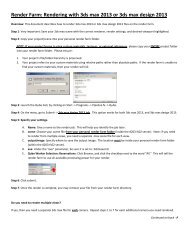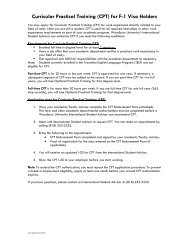50 Ways to Jumpstart Academic Integrity Discussions in Your Class
50 Ways to Jumpstart Academic Integrity Discussions in Your Class
50 Ways to Jumpstart Academic Integrity Discussions in Your Class
You also want an ePaper? Increase the reach of your titles
YUMPU automatically turns print PDFs into web optimized ePapers that Google loves.
541) Give students a passage <strong>to</strong> paraphrase. Have students trade papers, do peer reviews,and revise papers based on the peer feedback. Give group (vs. <strong>in</strong>dividual) feedback <strong>to</strong>the class, then have students rewrite aga<strong>in</strong>. Discuss key challenges studentsexperienced try<strong>in</strong>g <strong>to</strong> paraphrase.Cut-and-Paste Problems42) Discuss how “compil<strong>in</strong>g” a paper is different from “writ<strong>in</strong>g” a paper. Have each personwrite down 3-5 disadvantages of submitt<strong>in</strong>g a compiled paper. Discuss.43) In front of the class, illustrate how students sometimes “compile” papers by cutt<strong>in</strong>g andpast<strong>in</strong>g selections from other sources and mak<strong>in</strong>g superficial changes. Discuss.44) Show multiple variations of the cut-and-paste problem <strong>to</strong> help students see howcopy<strong>in</strong>g is wrong whether it’s one sentence, one paragraph, one page, or more. Havestudents rewrite selected passages us<strong>in</strong>g appropriate paraphras<strong>in</strong>g.Paper Mills, Buy<strong>in</strong>g Papers, and Other Steal<strong>in</strong>g45) In front of the class, critique a paper from an onl<strong>in</strong>e paper mill such aswww.cheathouse.com or www.schoolsucks.com. This activity can serve multiplepurposes such as teach<strong>in</strong>g about plagiarism prevention and proper citation, clue<strong>in</strong>gstudents <strong>in</strong> that you are aware of onl<strong>in</strong>e paper mills, and demonstrat<strong>in</strong>g the low qualitypapers they are likely <strong>to</strong> get from such sites.46) Present this scenario: your roommate reveals <strong>to</strong> you at midnight that she isdownload<strong>in</strong>g a paper from a free essay site because she is “freak<strong>in</strong>g out” that herpaper is due <strong>to</strong>morrow and she’s not ready. Should you do anyth<strong>in</strong>g? If not, why? Ifso, why and what?47) Discuss this scenario: <strong>Your</strong> roommate is mak<strong>in</strong>g money by writ<strong>in</strong>g papers for otherpeople. What do you do?What’s wrong with work<strong>in</strong>g <strong>to</strong>gether/collaborat<strong>in</strong>g on this assignment?48) Present a scenario such as this one: <strong>Your</strong> roommate asks if you have f<strong>in</strong>ished your paperand you say yes. She asks you <strong>to</strong> e-mail her your paper <strong>to</strong> give her some ideas <strong>to</strong> start herpaper. Discuss the follow<strong>in</strong>g:• How would you handle this situation? List at least three possibilities.• Discuss the implications of this situation for you? <strong>Your</strong> friend? Others?• What are various ways this situation could unfold? List several.49) Present 1-2 scenarios of collaboration issues your students might face, such as: Lab report <strong>in</strong> a science class A take-home test A homework assignment that it’s OK <strong>to</strong> discuss, but must be WRITTEN <strong>in</strong>dividually A group member not pull<strong>in</strong>g her/his share, but tak<strong>in</strong>g creditAsk students <strong>to</strong> develop possible ways <strong>to</strong> approach the situation and recommend a courseof action. Discuss what is and is not OK for your course. Discuss how students must know(and ask!) what’s OK for EACH course.<strong>50</strong>) Present a scenario such as this one: “<strong>Your</strong> roommate reviewed your paper and: Circlederrors. Corrected errors. Rewrote a few sentences. Rewrote several large passages. Gaveyou ideas for how <strong>to</strong> better construct your argument.” Ask students which of these actions areOK or not. Have your students grapple with collaboration that is acceptable and collaborationthat crosses the l<strong>in</strong>e. Be specific about what is and is not OK for your course.








